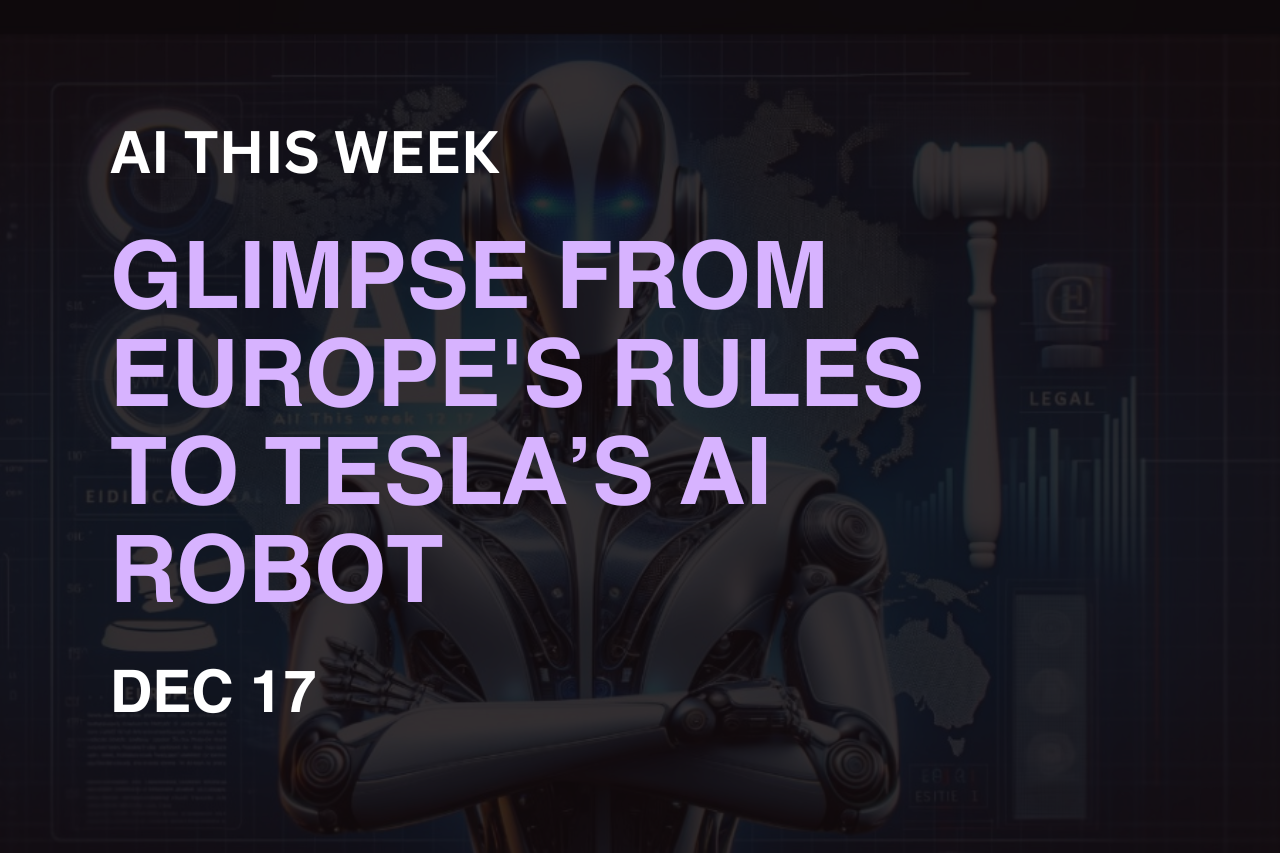
AI This Week: Glimpse from Europe’s Rules to Tesla’s AI Robot | Latest Developments in AI Technology & Robotics
Welcome to this week’s journey through the dynamic world of AI, where groundbreaking innovations and strategic developments are shaping our future. From Europe setting a global precedent with its comprehensive AI rules to MIT’s insights on AI governance, we are witnessing a transformation in how AI intertwines with policy and academia.
This week also highlights tech giants like Google and Microsoft pushing the boundaries of AI performance, while Intel introduces AI into our personal computing experience like never before. OpenAI continues to diversify its reach, from resuming ChatGPT Plus subscriptions to partnering with Axel Springer, illustrating the multifaceted nature of AI advancements.
We’ll delve into the promising frontiers of AI-driven products by Meta and Snapchat, and explore how emerging technologies like Mistral’s open-source model and Tesla’s latest AI robot are redefining the AI landscape. Join us in discovering these pivotal moments in AI history, shaping both our present and future.
Foundational AI Developments And Policies
Europe’s First Comprehensive AI Rules
On December 10, 2023, the European Union announced the Artificial Intelligence Act, a pioneering step in establishing global AI regulations. This act prioritizes safe and rights-respecting AI technologies in Europe, balancing fundamental rights with business growth. Key features include:
- General Purpose AI Safeguards: Restrictions on law enforcement’s use of biometric systems and bans on AI that exploits vulnerabilities.
- Prohibited AI Uses: Bans on AI applications in sensitive areas, including workplace emotion recognition and social scoring.
- Law Enforcement Exceptions: Conditions for biometric identification in public spaces.
- High-Risk AI Systems: Mandates on impact assessments and risk-based obligations.
- Support for Innovation: Encourages AI development, focusing on rights, democracy, and environmental sustainability.
Awaiting formal adoption, this act signifies Europe’s leadership in AI governance, emphasizing innovation alongside fundamental rights protection.
AI Development At MIT
MIT News reported on significant AI advancements on December 11, 2023. Notably, an MIT committee released policy papers guiding AI governance in the U.S. These papers propose regulating AI with existing frameworks, addressing challenges like misinformation and surveillance.
The main paper, “A Framework for U.S. AI Governance,” recommends extending current regulations to AI, ensuring a safe, thriving sector.
Additionally, MIT’s Generative AI Week in late November explored generative AI’s potential. The event included symposia on AI’s impact on education, health, creativity, and commerce.
It featured keynotes and panel discussions, showcasing generative AI’s transformative effects on learning and various industries. This event was a platform for dialogue on generative AI’s applications, highlighting MIT’s role in shaping AI’s future.
Major AI Developments By Tech Giants
Google’s AI Developments
Google has recently introduced AI Studio, a new web-based tool that simplifies app and chatbot development using the Gemini model. This user-friendly platform is part of Google’s broader AI ecosystem, designed to enhance the Gemini experience. AI Studio’s features include:
- Development Ease: Developers can easily create prompts, build Gemini-based chatbots, and secure API keys for app integration.
- Language Support and Quota: The platform supports multiple programming languages and offers a substantial free quota for developers.
- Integration with Google Services: AI Studio integrates smoothly with other Google developer tools, including Vertex AI, which focuses more on enterprise solutions.
Additionally, Google has launched a new AI-powered coding tool, similar to GitHub’s Copilot. This tool, likely integrated with Google’s AI platforms, provides advanced coding assistance, further cementing Google’s position in the AI development arena.
Microsoft Research’s Phi-2
Microsoft Research has made a significant stride in AI with the release of Phi-2, a compact yet potent language model AI, boasting 2.7 billion parameters. Despite its smaller scale, Phi-2 remarkably surpasses larger models like Meta’s Llama 2-7B and Mistral 7-B, and even outperforms Google’s Gemini Nano 2. Key features of Phi-2 include:
- High Performance: Surpasses larger AI models in performance while exhibiting lower levels of toxicity and bias.
- Device Compatibility: Engineered to run efficiently on laptops and mobile devices, Phi-2 is versatile and accessible.
- Usage and Licensing: Currently, Phi-2 is available for non-commercial research under Microsoft’s specific licensing terms.
Phi-2 represents Microsoft’s commitment to developing advanced yet accessible AI technologies, setting new benchmarks for performance and efficiency in the AI industry.
Innovations in AI-Driven Products and Services
Intel Core Ultra Mobile Processor Family
Intel has launched the Intel Core Ultra mobile processor family, heralding a new era in AI personal computing. This significant architectural shift emphasizes AI capabilities in PCs. The processors’ highlights include:
- On-Chip AI Accelerator: Features a neural processing unit (NPU) for enhanced power efficiency and AI acceleration.
- AI-Boosted Applications: Collaborating with over 100 software vendors, Intel is set to introduce hundreds of AI-enhanced applications, revolutionizing creative, productive, and entertainment experiences on PCs.
- 5th Gen Intel Xeon Processors: These new processors offer AI acceleration in every core, improving performance and efficiency significantly. They are ideal for demanding network and edge workloads in various sectors.
- Intel Gaudi3 AI Accelerator: A preview of this upcoming accelerator, designed for deep learning and large-scale generative AI models, showcases Intel’s commitment to meeting the growing demands for generative AI solutions.
Meta’s Audiobox
Meta has introduced Audiobox, an innovative AI model for generating voice and sound effects. This tool empowers users to create unique voices and sounds using voice inputs or text prompts. Key features of Audiobox include:
- Voice and Sound Creation: Converts text into speech that mimics recorded voices and generates custom voices and sound effects from text.
- Voice Modification: Allows modification of uploaded voice samples to create new sounds.
- Advanced Audio Tools: Includes Magic Eraser for noise removal and Sound Infilling for adding effects to existing audio.
- Voice Cloning Program: As a free voice cloning tool, Audiobox is part of Meta’s initiative to advance AI in audio generation, offering users unprecedented control and creativity in audio content creation.
Snapchat’s AI Features for Plus Subscribers
Snapchat has expanded its AI features for Snapchat Plus subscribers, introducing an innovative way to generate images from text prompts. The update includes:
- AI-Generated Images: Users can create images by entering text prompts, accessed via an “AI” button on the toolbar.
- Photo Extension: The AI can ‘extend’ photos by filling in the surrounding environment, enhancing creative possibilities.
- Ease of Use: The generated images can be easily edited and shared directly on the app.
- Exclusive to Subscribers: These new AI features are exclusively available to Snapchat Plus subscribers, adding value to the subscription service.
This update marks Snapchat’s further integration of AI into social media, offering subscribers novel and engaging ways to create and interact with visual content.
OpenAI’s Multiple Facets and Developments
OpenAI Resumes ChatGPT Plus Subscriptions
OpenAI has reopened subscriptions for ChatGPT Plus, as announced by CEO Sam Altman. This follows a temporary suspension due to limited GPU capacity, heightened by the overwhelming demand after the launch of GPT-4 Turbo and other new features.
ChatGPT Plus provides access to advanced functionalities, including GPT-4-Turbo, DALL-E 3, and a code interpreter. The service is regaining popularity, with web traffic approaching its April 2023 peak, thanks to increased usage in educational settings and continuous product enhancements. This move reflects OpenAI’s efforts to scale up its resources and meet the growing demand for advanced AI services.
Dismissal of GPT-4.5 Leak
OpenAI’s CEO Sam Altman has publicly dismissed a leak regarding GPT-4.5’s capabilities and pricing. The leak, which circulated on platforms like X and Reddit, claimed that GPT-4.5 would offer multi-modal functionalities across vision, video, audio, language, and 3D, along with enhanced reasoning and cross-modal understanding.
It also suggested a revised pricing model for the update. However, Altman’s categorical dismissal of this leak casts doubt on its accuracy.
ChatGPT Partners with Axel Springer
OpenAI has entered a strategic partnership with Axel Springer, a major news conglomerate owning media brands like Business Insider and Politico. This collaboration aims to enhance ChatGPT by integrating real-time information from Axel Springer’s publications.
The deal will allow ChatGPT users to access summaries of global news content, accompanied by attributions and links to full articles, ensuring transparency and detailed information. While this partnership boosts ChatGPT’s capabilities in providing recent news, it doesn’t yet match the real-time user post dataset of Elon Musk’s Grok.
The move represents a significant step in enriching AI-driven information services and positions ChatGPT as a strong competitor in accessing and processing real-time news content.
Alter3, OpenAI-Powered Humanoid Robot
Developed by the University of Tokyo, Alter3 is a groundbreaking humanoid robot powered by OpenAI’s GPT-4. This robot represents a major advancement in AI-driven robotics, capable of spontaneously adopting various poses and executing actions without explicit programming.
Alter3 leverages GPT-4’s language understanding to interpret and respond to voice commands, translating them into physical actions. This includes complex motions like taking selfies, marking a significant leap in bridging AI language models with physical movement.
Alter3’s ability to understand and perform tasks based on verbal instructions showcases the potential for integrating AI in robotics, offering a glimpse into future applications where robots can interact more naturally and intuitively with humans.
YouTuber’s Live Demo of GPT-4 Vision
YouTuber ‘Greg Technology’ made a notable impact by replicating Google’s Gemini AI demonstration in real-time using OpenAI’s GPT-4 Vision. In contrast to Google’s demonstration, which faced scrutiny for its staged nature with post-recorded voice interactions, Greg’s demo was conducted live, adding a layer of authenticity and practicality.
His demonstration included dynamic interactions involving drawings, emoticon queries, and game identification, showcasing the real-time functionality of GPT-4 Vision. This live execution not only demonstrated the capabilities of GPT-4V but also served as a subtle critique of Google’s approach, highlighting the potential for more genuine and unscripted AI demonstrations.
Greg’s initiative, less refined yet more transparent than Google’s, underscored the real-world applicability of advanced AI technologies. By sharing the demo code on GitHub, he further contributed to the AI community, illustrating the versatility and accessibility of OpenAI’s advancements.
Emerging and Disruptive AI Technologies
Mistral’s Groundbreaking Open-Source AI Model
Mistral, an emerging AI startup based in Paris, is making waves with its cutting-edge Mixtral 8x7B model. This model, a product of collaboration among 22 former DeepMind and Meta experts, utilizes a unique ‘mixture of experts’ approach.
It stands out for its ability to match or even outperform established AI models like OpenAI’s GPT-3.5 and Meta’s Llama 2, while being efficient enough to operate on standard devices. The Mixtral 8x7B, available under the Apache 2.0 license for commercial usage, offers expansive possibilities but also raises questions regarding regulatory oversight due to its open nature.
Bolstered by a significant $415 million investment, Mistral is poised to unveil even more sophisticated AI models. Their Mixtral MoE model is multilingual and exhibits impressive benchmarks, indicating a significant leap in AI development. Additionally, Mistral’s recent API service launch signifies its commitment to expanding accessible, high-performance AI tools.
Tesla Unveils Enhanced AI Robot: Optimus Gen 2
Tesla has taken a major leap in AI-driven robotics with the unveiling of its new and improved Optimus Gen 2 humanoid robot. This iteration marks a substantial upgrade from its initial prototype, showcasing Tesla’s dedication to refining AI hardware.
The Optimus Gen 2 robot is both lighter and faster than its predecessor, with a 22 lb weight reduction and a 30% increase in movement speed. Notable improvements include:
- Advanced Mobility: Enhanced with a more human-like balance and full-body control.
- Sensitive Tactile Abilities: All fingers are equipped with tactile sensors for the precise handling of delicate objects.
- Greater Flexibility: Improved motion range in the hands and neck for more natural movements.
This release from Tesla signifies a pivotal moment in AI hardware, demonstrating substantial progress in the field. With advancements like these, Tesla continues to push the boundaries of AI and robotics, underscoring the potential for more sophisticated, human-like robots in the near future.
Final Thoughts
As we wrap up this week’s overview of the AI landscape, we’re reminded of the extraordinary pace at which this field is evolving. The groundbreaking developments we’ve witnessed reflect a world increasingly influenced by artificial intelligence.
From the intricacies of policy frameworks to the unveiling of AI-enhanced hardware, each story contributes to a larger narrative about the role of AI in shaping our future. We’ve seen AI not just as a tool for technological advancement but as a catalyst for broader societal and ethical considerations.
As AI continues to integrate into various facets of our world, it prompts us to consider not only its limitless potential but also the responsibilities that come with such power. Let’s look forward to more transformative developments in this ever-evolving AI odyssey.



